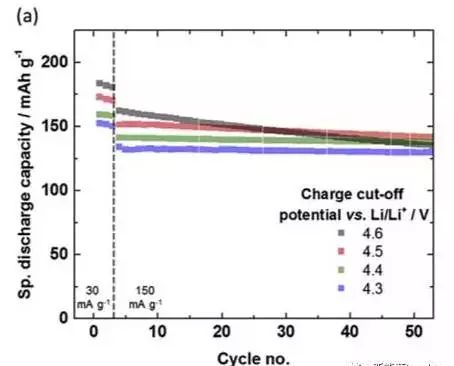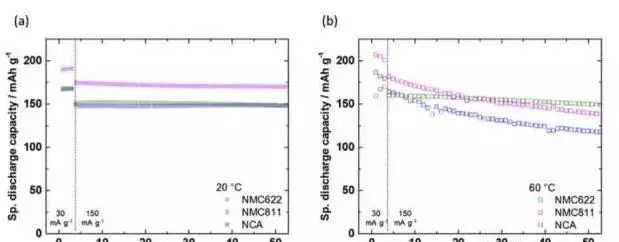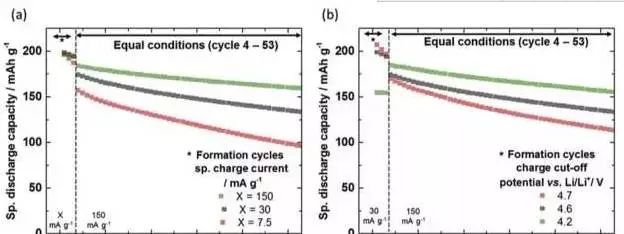In general, the ternary materials commonly referred to are mainly NMC (Nickel-Manganese-Cobalt) and NCA (Nickel-Cobalt-Aluminum) materials. The capacity of layered materials is significantly influenced by their structural stability. Since Ni³⺠is more chemically stable than Co²âº, NMC materials can undergo greater lithium removal during the charging process, which leads to a substantial increase in material capacity.
As the energy density of lithium-ion batteries continues to rise, traditional lithium cobalt oxide (LCO) materials are gradually being replaced by higher-capacity ternary materials. Although these ternary materials share a similar layered structure with LCO, they offer not only improved capacity but also better thermal stability compared to LCO. This makes them more suitable for high-performance applications.
However, the structural stability of layered oxide cathode materials is also affected by the degree of delithiation. Excessive lithium extraction can lead to structural collapse, reducing the material’s performance over time. To maintain the structural integrity of NMC materials, it's essential to limit the charge cut-off voltage, ensuring long-term cycle stability and durability.
Johannes Kasnatscheew from the University of Münster in Germany conducted a study on the structural stability of several NMC and NCA materials, including NCM111 and NCM532 (from BMW Group), NCM622 and NCA (from Customcell), and NCM811 (from Shanshan Technology). His research focused on how different factors affect the performance and stability of these materials under various conditions.
One key factor analyzed was the effect of the charge cut-off voltage. The amount of delithiation in NMC materials is directly proportional to this voltage—higher voltages result in more lithium being removed, which increases the risk of structural instability. For example, increasing the cut-off voltage improves initial capacity but accelerates degradation over time.
The figure below shows the cycle performance of NCM811 at different cut-off voltages. While the specific capacity at the fifth discharge is highest at 4.6V, after 53 cycles, its capacity drops rapidly compared to lower cut-off voltages. This indicates that while higher voltages can boost capacity, they come at the cost of reduced cycle life. Therefore, selecting an appropriate cut-off voltage is crucial based on the intended lifespan of the battery.

The next set of data compares the discharge energy and energy retention of various NMC and NCA materials after 53 cycles. Interestingly, the highest discharge energy density isn't always achieved at the highest cut-off voltage. For instance, NMC811 achieves maximum energy density at 4.3V, while NMC622 and NCA perform best at 4.4V. NMC111 reaches its peak at 4.5V. These findings suggest that optimal performance depends on balancing voltage with structural integrity.
As the number of cycles increases, the rate of degradation becomes more pronounced at higher cut-off voltages. The trend in the cycle curves shows that lower cut-off voltages may result in slower energy loss, but higher voltages often lead to faster capacity decline. Materials with lower nickel content, such as NMC111, NMC532, and NMC622, are especially sensitive to voltage changes, indicating weaker structural stability under stress.

Another important factor is environmental temperature. High temperatures can improve battery kinetics, leading to better performance, but they also negatively impact cycle stability. Johannes Kasnatscheew studied the cycling performance of NMC622, NMC811, and NCA at both room temperature (20°C) and 60°C. At 60°C, the capacity retention of NMC811 and NCA dropped significantly after 50 cycles, whereas NMC622 showed better thermal stability.

Additionally, the chemical current during charging plays a role in cycle performance. Too much current can cause overpotential and reduce the usable capacity over time. To address this, Kasnatscheew designed an intelligent charging system that controls the cut-off voltage and ensures consistent charging capacity, effectively improving the battery’s cycle life.

Overall, the study highlights the complex interplay between charge parameters, temperature, and material composition. By optimizing these factors, it's possible to enhance the performance and longevity of ternary lithium-ion batteries, making them more viable for future energy storage solutions.
2) Each unit can counter up to 3 frequency bands simultaneously, each frequency band is separate and with adjustable power from max to off (0).
3) 100% safe VSWR over protection (isolator) for each modular.
4) Big aluminum alloy shell and cooling fans, not-stop to work.
5) IP54 Design for outdoor installation, Secure design to avoid sabotage.
multi Band Noise Source Anti Drone System,Drone Defense,Confronting Fpv Drone
Jiangsu Yunbo Intelligent Technology Co., Ltd , https://www.fmodel-ai.com